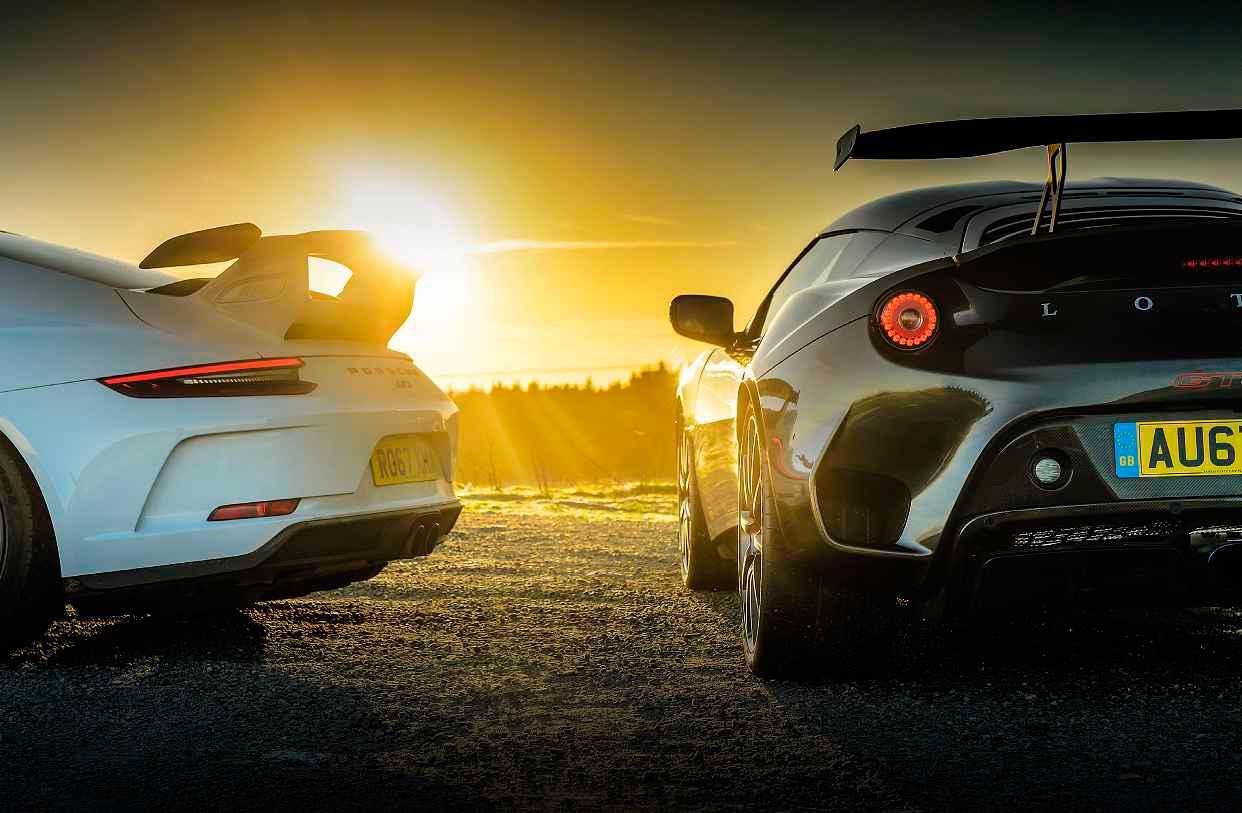
Porsche 911 GT3 991.2 versus Lotus Evora GT430 Has the fastest and most extreme Evora to date got what it takes to topple the all conquering GT3? The Evora GT430 is the fastest, most expensive road-going Lotus to come out of Hethel. But is it enough to oust the mighty Porsche 911 GT3 from its lofty perch? We take them to Wales to find out. Text by John Barker. Photography by Stephen Hall.
DARK KNIGHT
It’s a big ask, beating the 911 GT3 991.2, a car that’s been at the top of its game for nearly two decades, but if there’s a Lotus that can, it’s the Evora GT430. Like the 911, the Evora has been in a constant state of evolution, getting lighter and more powerful with each new version. The limited-edition GT430 offers the best power-to-weight ratio of any Evora so far and, frankly, we’d be gutted if it didn’t, because up close it looks like it’s made entirely from carbonfibre… and it comes with a price tag that suggests as much. But we’ll come back to that. Right now there’s some testing Welsh asphalt to tackle, and the first unexpected discovery to be made.
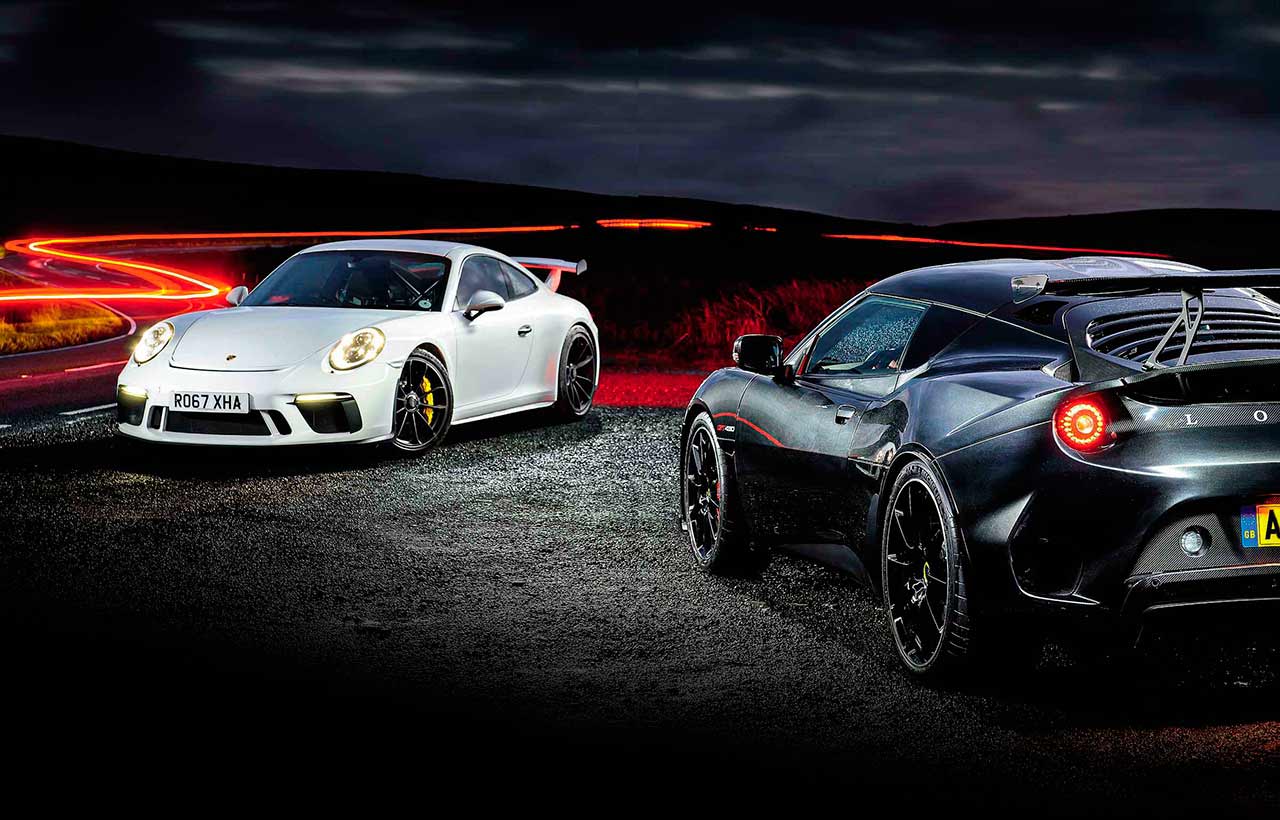
The sun is out and the temperature is mercifully above freezing, but an ambient of 7deg C means that the Michelin Cups fitted to both cars are just below their operating range. Adding to the challenge, the surface is wet. With senses on high alert I set off in the Lotus and within a couple of corners I’m surprised at the level of traction and grip. The further I go, and the more of this undulating, twisting and difficult road that passes beneath the GT430’s wheels, the more impressed I am. Even working the growly V6 hard, I can’t seem to unstick the fat rear tyres.
It’s so good that I wonder if there’s very subtle electronic intervention going on behind the scenes, keeping everything under control. To test that theory, I go through the motions to turn off the traction control, which involves a combination of TC and Race mode button pushing. A few more miles and the Lotus remains as hooked up and on line as before.
I wasn’t expecting that. Nor was I expecting the GT430 to ride as well as it does. It may look like a roadgoing race car but it clearly takes the ‘GT’ part of its name seriously. Either that or Lotus’s chassis engineers just can’t bring themselves to make a car that doesn’t breathe with the road. The GT430 glides over tricky surfaces all of a piece, yet the sporty tightness of control you’d hope for is there too in the lack of pitch and roll and the crispness of response. It’s a remarkable blend of skills.
The 911 should feel as hooked up as the Lotus in these conditions. It’s a modern mystery how its masses can feel so balanced when there’s a flat-six-shaped lump of metal hanging out the back, like a burly bloke on the other end of a see-saw. Logic says the engine is in the wrong place, except in conditions like these, when its leverage should help pin the GT3’s fat rear Michelins to the road.
After the Lotus, the first things that strike you are that the 911’s full bucket seats (optional) are more generously cut and that as soon as you’re rolling, there’s a chatter of feedback through the slimmerrimmed but larger-diameter steering wheel. So you know what’s happening at the tread blocks of the front tyres, which is handy because the 911 has less traction than the mid-engined (albeit only just) Evora.

I didn’t see that coming, and the reason is unclear. The Porsche’s rear tyres are slightly fatter – 305/30 R20 versus 295/30 R20 – but they don’t have to cope with a chunk more torque; the GT3’s 4-litre flat-six delivers 339lb ft at 6000rpm, while the GT430’s supercharged 3.5-litre V6 churns out 325lb ft at a more accessible 4500rpm. A few more miles confirm that the 911 has less rear grip, but because it has a front end that lets you know what’s going on, it isn’t an issue; you feel informed, engaged in the process, confident that you know what’s going to happen.
Parked beside each other, these two hardcore drivers’ cars look quite different, both in proportions and theme. In all white, with its centre-lock wheels and visible half cage, the 911 looks like it could be one of a batch of identical homologation cars awaiting a set of slicks, sponsor’s livery and the first shake-down test of the season. On the other hand, with its swathes of exposed carbonfibre and mid-engined proportions, the Evora looks like a miniature supercar embodying recent GT race car aerodynamic thinking. Its nose is made up of multiple sculpted components, there are wing-top slats for venting the front wheel wells and ducts for the rears, plus a high-mounted rear wing. While the standard Evora profile gives it a push-me-pull-me look, the GT430’s aero addenda, deleted rear side glass and bigger rear wheels and tyres give it a dart-like profile.
This dark, stealthy example is number one of a limited edition of 60, all of them sold despite a list price before options of £112,500. That makes it the most expensive Lotus ever, and it claims a number of other Lotus records too, including most powerful production model (430bhp) and fastest top speed (196mph). Impressive stuff, though there are a couple of caveats. In 2012 Lotus made the even more limited edition Evora GTE (just 25 made) to homologate its GTE-class racer, and that had a claimed 438bhp. Meanwhile, the fastest top speed goes to the ‘Sport’ version of the GT430, which makes do without the bold rear wing and has less drag.
The bewinged car goes to ‘just’ 190mph, but the extra downforce it creates – 250kg at max speed compared with 100kg for the Sport – helps lop a second off its Hethel lap time and means that the GT430 matches the 1min 25.8sec set by the stripped-back 3-Eleven.
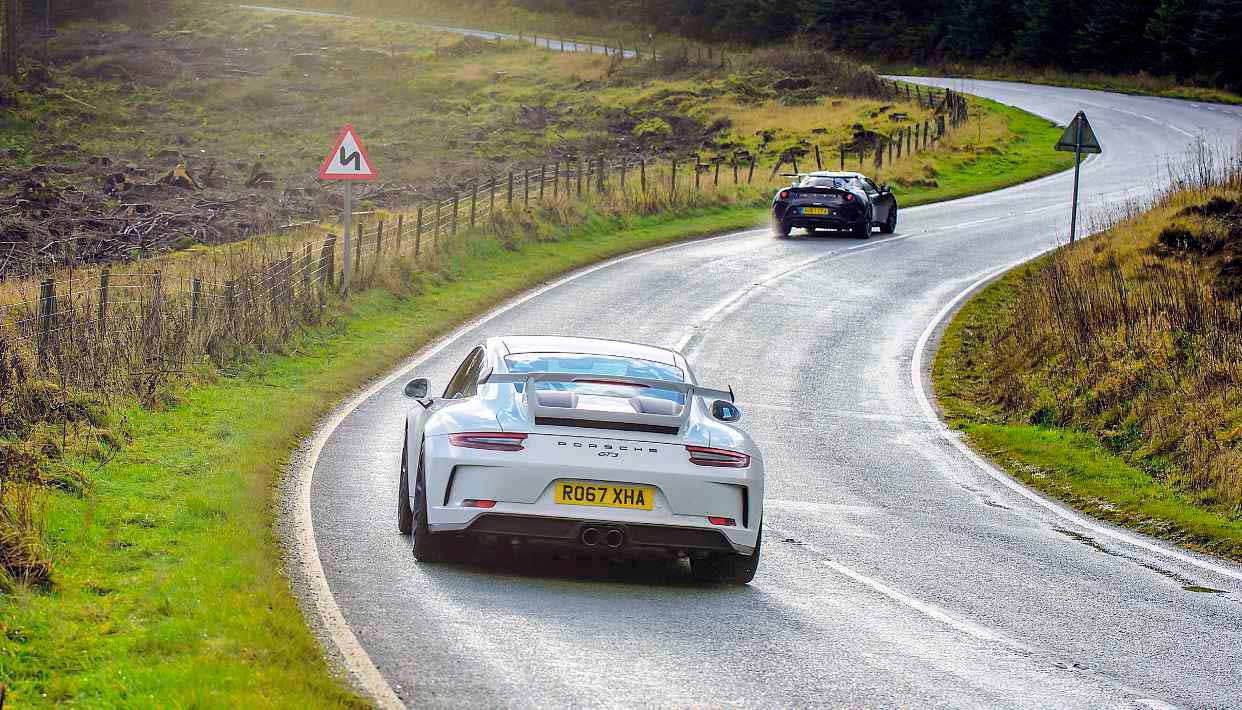
The Sport is the lighter of the two versions, too, by 10kg, but if you’re spending over £100k on an Evora you might as well go the whole hog. This example has optional metallic grey paint that from a distance disguises just how much carbonfibre there is on show. The front and rear bumper aprons are carbon but mostly painted, but the front ‘bonnet’, the roof and the engine cover are all in lacquered carbonfibre, and it’s beautifully done, particularly the roof with its centreline join giving a herringbone effect.
Some of these panels were first seen on the previous lightest Evora, the Sport 410. The big contributors that make the GT430 26kg lighter still are an even greater use of carbonfibre (-4.7kg), a titanium exhaust (-10kg), new adjustable Eibach/ Öhlins spring/damper units (-10kg), and a number of detail savings (-10.3kg). Offsetting that 35kg by 9kg is the new rear wing plus wider wheels and tyres.
Mind, whichever way you cut it, a 1299kg kerb weight for a car of this scale and performance is a fine achievement and true to the Lotus philosophy. Porsche might not use such obviously lightweight materials for the GT3 but its body is a clever fusion of high-tensile steel and aluminium and, like the Lotus, its rear seats are deleted. The GT3 is no heavyweight but at 1413kg, it gives away 114kg to the GT430.
There’s no impression that the Lotus has been stripped out, either. The interior has come a long way since the Evora’s 2009 launch. It’s now a neat confection of Alcantara and perforated and smooth leather with contrasting stitching, and the instruments are much more convincing than the originals, with clear white-on-black faces and red needles. The Sparco seats do look small and minimalist though, their carbon shells trimmed with just enough padding and material to offer comfort and durability. The fixed backrest angle is a fraction too upright for me and it seems it can’t be adjusted beyond sliding it fore and aft, even if you’re handy with an Allen key. The driving position is all pretty square, the aluminium pedals decently spaced, the clutch light.

Fire the engine up and it gives a characteristic V6 growl before settling to a steady idle. Snick the lever into first and you sense the improvements to the gearshift: the action is tighter, firmer, more positive. The gearing still seems quite tall, though, with second gear stretching to 70mph and therefore more than enough for the cut and thrust of B-roads. Even so, there’s a real and very appealing sense of a lightweight car propelled by a torquerich engine. The response of the Toyota-derived V6 is enhanced by a low-inertia, single-mass flywheel, and even the roll-on in fourth is impressive, the engine digging in from 2000rpm and trumpeting its enthusiasm through the central pipe.
It’s pretty vocal, though not as painfully loud as the example Adam Towler tried in, probably because among the options fitted to this car is the sound insulation pack. It costs £500 and when added to the others – metallic paint (£1200), ‘premium’ infotainment head unit, sub-woofer and amp (£2400), air con (£1500), black machined-rim forged wheels (£900) – brings the total to £119k, and presumably adds a few kilos, too.
‘The 911 takes the level of engagement to another plane, delivering rewards at all speeds’
The Porsche also has some options, bumping its price from a list of almost £112k to £130k. They include LED headlamps, front-axle lift, carbon-ceramic brakes, leather interior and those bucket seats. They’re fixed-back, like the Lotus’s, but with electric cushion height/tilt adjustment allowing the backrest angle to be trimmed. On the lowest setting it feels like you’re sitting on the floor but, as ever, the superb all-round visibility of the 911 helps put you at ease. In contrast, rear visibility in the Evora is compromised by the slatted engine cover and the lack of rear side windows, especially at oblique junctions.
Their power-to-weight ratios say the two cars should feel equally quick. The lighter Lotus weighs in with 336bhp per ton, the more potent Porsche packs 355bhp per ton, its naturally aspirated flat-six making 493bhp at 8250rpm. They do seem similarly rapid, but in different ways. The Evora’s delivery is punchier low down and overall more linear, its gutsy supercharged V6 really starting to push on at 4000rpm but then seemingly cut off in its prime by the abrupt limiter soon after 7000rpm. After a relatively less gutsy start, the 911 is also digging deep by 4000rpm and by 6000rpm is really starting to wind up. Just as the Evora engine heads for the buffers, the 911’s makes that magical, thrilling move of fully hitting its stride, crazily escalating both the power and the sound to 8000rpm and beyond. It’s electrifying, nape prickling, and for the full-on experience you need to hold it from tickover to 9000rpm in one gear.
We’ve mostly driven the 991.2 GT3 in PDK form, but the six-speed manual, as fitted here, makes for a better, more nuanced experience. Forays into the upper realms of the rev range are less frequent and more special because you lean on the engine’s torque more, when the PDK would have dropped a couple of cogs and ripped on to the red line. A beneficial side-effect is that you encounter the uncomfortable 7000rpm resonance less often. The shift is darned good, too. The Evora’s ’box has a lovely, positive, mechanical feel, but the 911’s feels tighter and even more slick, and the clutch weight feels more in harmony with the other controls.
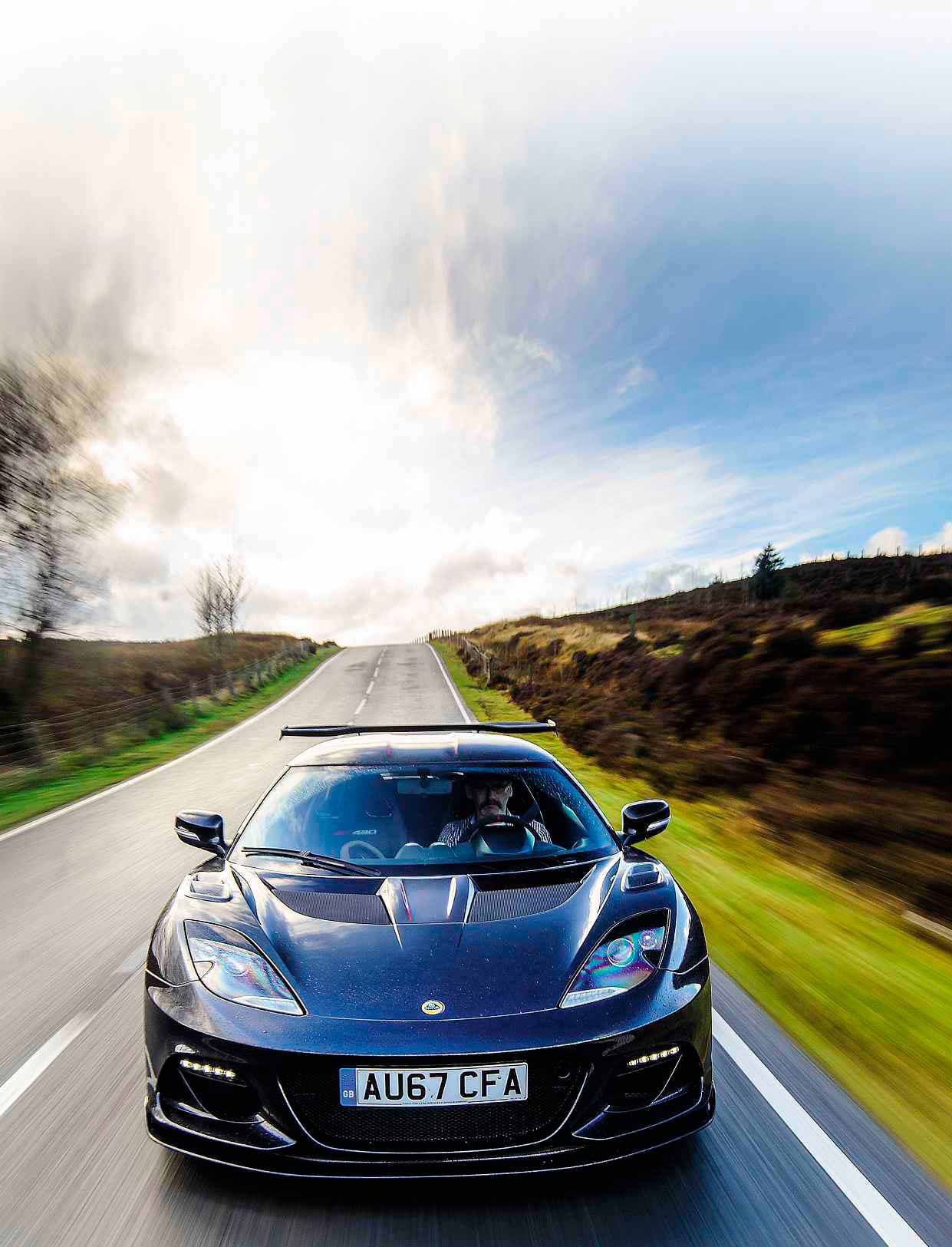
In all cars, time behind the wheel allows you to acclimatise to their controls and foibles, then adapt to them. However, when you then swap into a car that has better control weights and more linearity of response, you notice right away. After the Evora, the GT3 is such a car. You can get into a satisfying groove with the Lotus, and there is much to enjoy and admire, not least the finesse displayed by its ride, which smooths away small imperfections and delivers great control over the bigger stuff for remarkably poised, calm progress, with fantastic grip, too.
Then you get into the Porsche and, although it’s not perfect, so much of it is so right, and it starts with the steering. It’s not as sharp as the Lotus’s but it’s connected and talkative and paints a clear picture of what’s happening that puts you at ease. Not so long ago, electric power steering, such as the 911 has, was judged inferior in feel to hydraulic power steering (now rare), which the Lotus has. This was certainly the case when the first generation 991 was new, but Porsche has been working hard on closing the gap. The sportiest 991s benefit from rear steering, sharpening initial response, but equally impressive and harder to deliver is detailed feedback. The GT3 has it in spades.
‘The weight, smoothness and directness of the steering are spot on, but it lacks that crucial amount of feedback that gives confidence’
The next day starts frosty. You get a warm feeling being in the GT430; it’s the best built of all the Evoras I’ve tried, with such a reassuring sense of quality and integrity. However, heading east on the A5 out of Betws-y-Coed, up the twists between the stone walls, I’m feeling for icy patches, which again highlights the Lotus’s lack of feel. The weight, smoothness and directness of the steering are spot on, but it lacks that crucial amount of feedback that gives confidence.
Further out, pressing on, the weighting becomes a fraction light and inputs reveal a light front, heavy rear balance of masses that tempers your pace a little. Getting into the 911 again confirms this. Its steering is more natural, authentic – the response you get for the input you make is spot on. But it’s also the overall balance that makes a difference. The Porsche feels lower slung, and although its engine is way out back, it doesn’t feel like it; the car turns like all the masses are gathered between the axles. It’s quite some feat of engineering.
The contrast becomes even sharper through the wet bend we choose for some cornering shots. I take the GT3 first, which is in itself an indicator of confidence. I do a run with all the aids on, to sense the grip, then go again with ESC and TC off. The front catches the apex, the rear slips out under power, and I back out and neutralise. Next time through, I stay with the slip and hold the power steady for a few moments. It feels nicely poised, comfortable with the attitude; and you as the driver have control and options.
The Evora is, well, less good. In fact, all that has been hinted at over the miles we’ve covered crystallises here. First, the front doesn’t want to bite and the rear doesn’t want to let go, so next time through, I’m more patient and let the front hook into the turn and then power up the rear. It slips wide but the breakaway is too quick, too sudden. Back off and the momentum-loaded rear regains grip abruptly and the tail bounces back into line. Not smooth, not calm, not reassuring. This is much like the behaviour you’d expect of a full-scale mid-engined supercar. Sure, there’s a six-position traction control allowing you to dial in rear-tyre slip values between one and 12 per cent, but essentially the Evora does not feel as poised or balanced at or over the limit. In fact, the Lotus feels more like a 911 than the Porsche does.
What makes it more of a challenge is that lack of steering feel. Feelsome steering used to be one of the most rewarding aspects of the Evora, and the GT430 shows why it is so important. Without it, it’s difficult to feel the bite that the front has and thus what the rear might do if you push harder. And given that the balance isn’t there and the rear feels like the tail wagging the dog, that’s a crucial loss.
There are a few other aspects that rankle: the shut lines are large, as if drawn with a crayon, where the Porsche’s are drawn with a Rotring 0.5mm fine pen, and the ignition key and column stalks are inexpensive Ford parts, circa 1983.
That said, in many more important respects, this is a deeply impressive car. The standard of the carbonfibre work is very high, there’s a real sense of quality and integrity, and the engine and gearbox have character and purpose. And, as ever, the ride quality is exceptional and allied to superb body control.
In the end though, as with most other rivals that have strayed onto its patch, the GT3 comes out on top. It’s not as special to look at, it isn’t made from obviously exotic materials, it’s not as rare and it isn’t even the top of the 911 tree. It is also somewhat unobtainable, with significant premiums being sought right now.
Whether it’s worth almost £200k is debatable, but there’s no question it is a very finely honed, very satisfying drivers’ car. It has superb steering feel and thus gives a better sense of connection with the road at all times, but especially when you’re pressing on and feeling out the limits. And, against expectation, at and beyond the limit it is better balanced and more exploitable than the Evora. Equally importantly, though, the slick, short-throw shift of the manual gearbox transforms the experience compared with the PDK car, making it much more a tool of the driver rather than just a crazy-fast ride.
It takes the level of engagement to another plane, delivering rewards at all speeds, not just when the spectacular flat-six is keening for the 9000rpm red line, and ultimately helps ensure that the GT3 still sets the sports car standard.
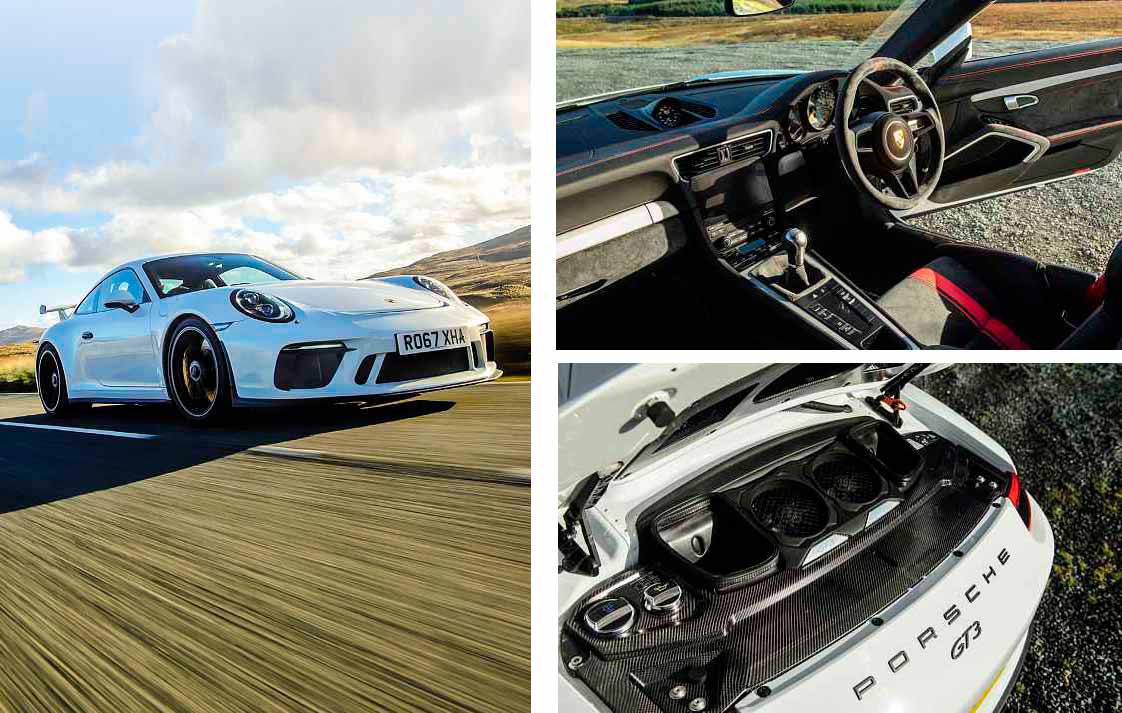
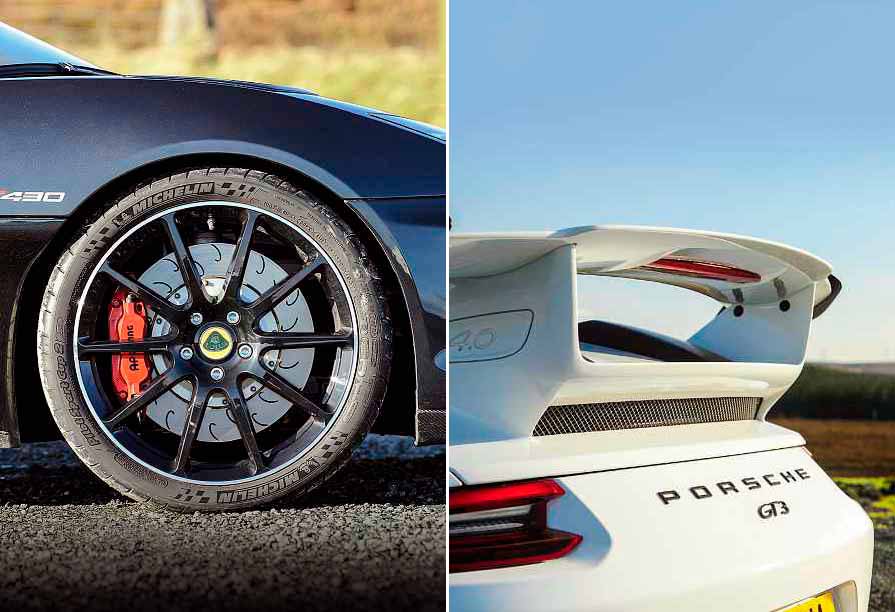
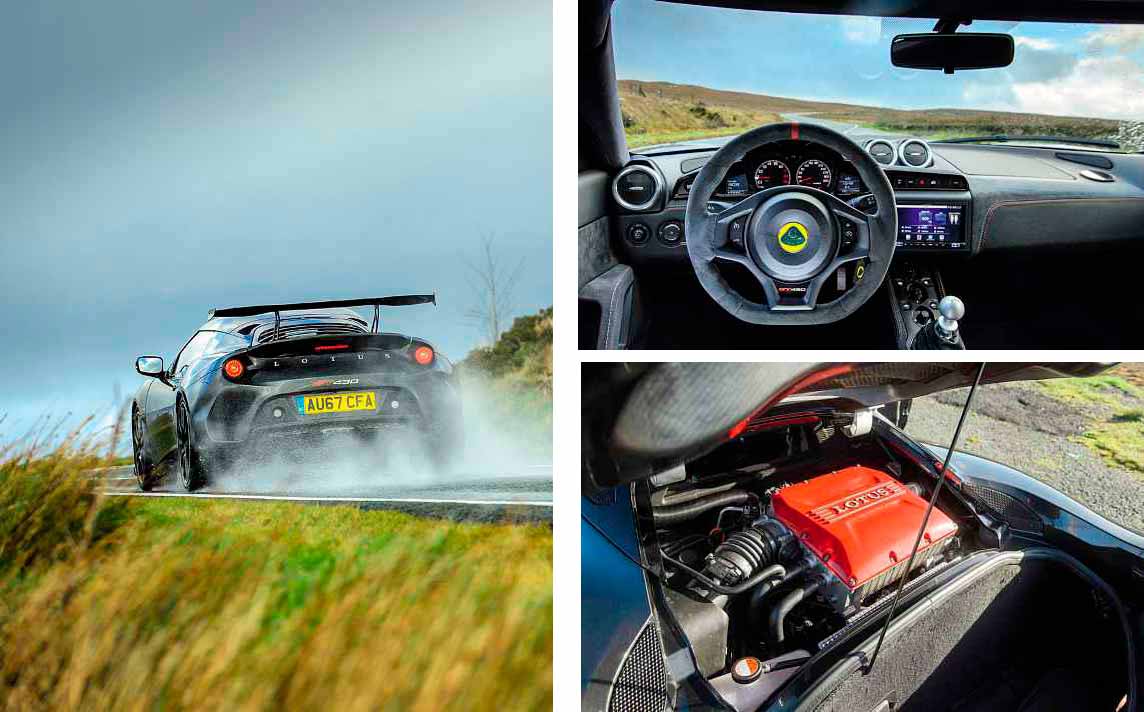
TECHNICAL DATA FILE SPECIFICATIONS PORSCHE 911 GT3 991.2
Engine Flat-six, 3996cc
Power 493bhp @ 8250rpm / DIN
Torque 339lb ft @ 6000rpm / DIN
Transmission Six-speed manual, rear-wheel drive, limited-slip differential
Tyres 245/35 ZR20 front, 305/30 ZR20 rear
Weight 1413kg
Power-to-weight 355bhp/ton
0-62mph 3.9sec (claimed)
Top speed 198mph (claimed)
Basic price UK 2018 £111,802
On sale Now (2018)
Drive-My rating 5.0
{module PORSCHE 991}
TECHNICAL DATA FILE SPECIFICATIONS LOTUS EVORA GT430
Engine V6, 3456cc, supercharger
Power 430bhp @ 7000rpm / DIN
Torque 325lb ft @ 4500rpm / DIN
Transmission Six-speed manual, rear-wheel drive, limited-slip differential
Tyres 245/35 R19 front, 295/30 R20 rear
Weight 1299kg
Power-to-weight 336bhp/ton
0-62mph 3.8sec (claimed)
Top speed 190mph (claimed)
Basic price UK 2018 £112,500 +tax
On sale Now (2018)
Drive-My rating 4.5
{module Lotus Evora}





